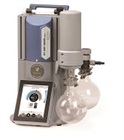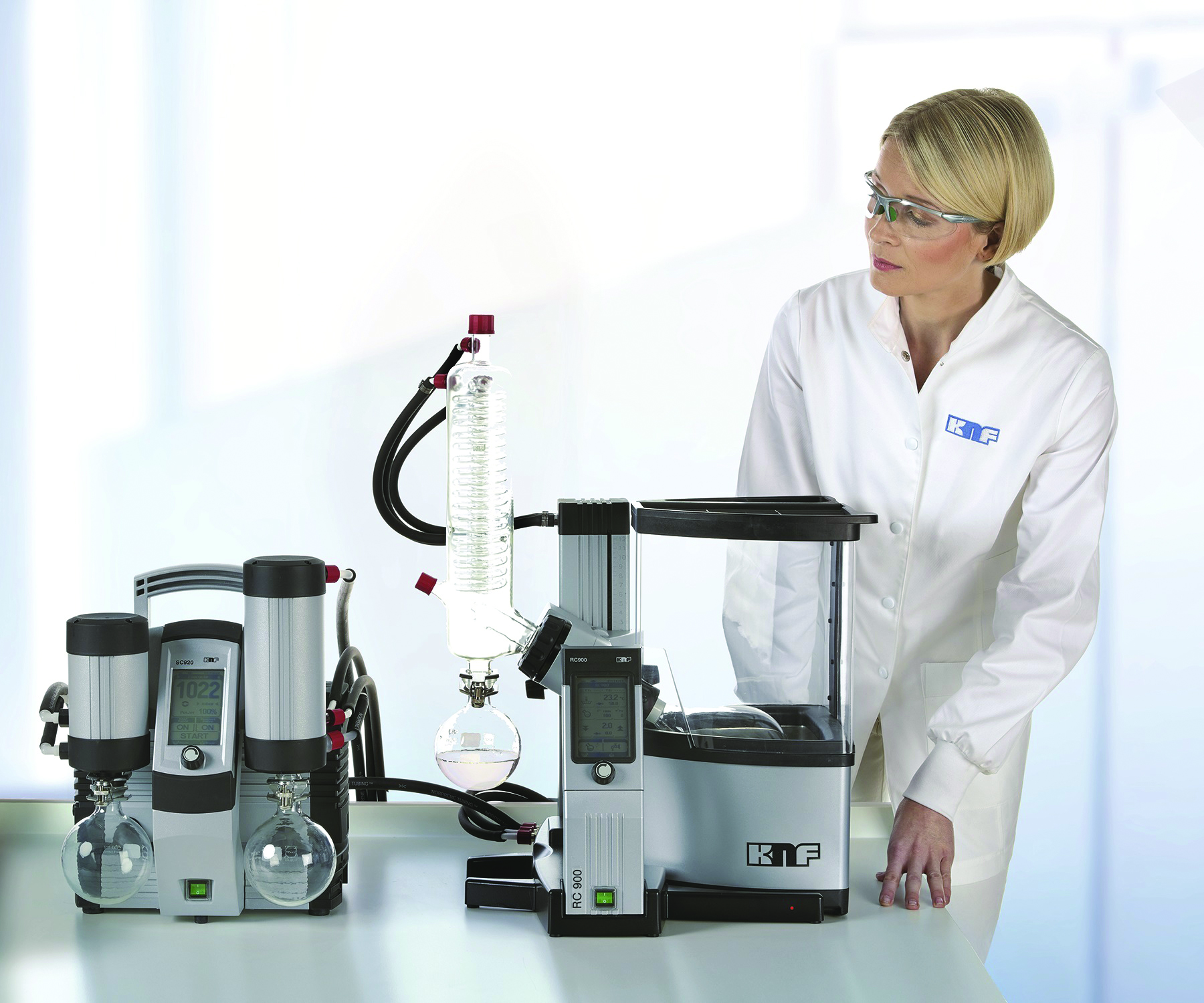Featured Article

A vacuum can be created with several different technologies, but some questions must be answered to pick the best choice
When looking for a lab vacuum pump, some basic research should be done before diving into the available options. The market for vacuum pumps contains many kinds of units to consider. Taking some time to answer a couple of basic questions makes it easier to purchase the best unit for a lab.
 KNF’s SC 920 G vacuum pump system (left) being used for rotary evaporation. (Image courtesy of KNF USA.)
KNF’s SC 920 G vacuum pump system (left) being used for rotary evaporation. (Image courtesy of KNF USA.)According to Akbar Anwari, marketing manager at BrandTech Scientific (Essex, CT), the first question to ask is: What is the job that the pump is performing? “Using a vacuum pump to move liquids, like in filtration or aspiration, requires one level of vacuum; evaporation typically an order of magnitude deeper; and freeze-drying another order or two of magnitude deeper,” Anwari explains. “But using a freeze dryer pump for filtration isn’t just overkill, it will evaporate the filtrate, and a filtration pump won’t perform freeze-drying either.” Anwari adds, “So ‘rightsizing’ the pump for the application is important.”
The second key question is: Where are the liquids going? “If you are using a vacuum pump to evaporate solvents, those solvent vapors don’t magically disappear,” Anwari says. “Fortunately, diaphragm pumps made of flouropolymers can allow many corrosive vapors to pass through the pump without damage.”
Depending on a lab manager’s knowledge of vacuum pumps, another route is an option. As Scott Leahy, director of technical marketing at VACUUBRAND (Essex, CT), explains, “Because the process of finding the best vacuum pump for the job can be somewhat involved, often one of the most important questions to ask is: Who can I talk with about this?” He adds, “Vacuum-pump manufacturers have sales, marketing, and customer service teams who are trained on the wide range of lab applications that require vacuum, and they are there to help lab managers answer exactly this type of question quickly and accurately.”
 VACUUBRAND PC 3001 VARIO select vacuum system, featuring adaptive control and touchscreen interface. (Image courtesy of VACUUBRAND.)
VACUUBRAND PC 3001 VARIO select vacuum system, featuring adaptive control and touchscreen interface. (Image courtesy of VACUUBRAND.)In addition, the old-school approach of asking around never hurts either. If a lab needs a vacuum pump for a particular application, it’s worth the time to find another lab doing similar work and find out what pump it uses.
Now, let’s look a little deeper to what a lab manager needs to know and how that knowledge can be used.
Detailed decision-making
If a customer knows what performance is required from a vacuum pump, then Roland Anderson, laboratory products manager at KNF USA (Trenton, NJ), suggests a list of specifics to consider:
- Flow capacity
- End vacuum
- Outlet pressure
- Pumped media (i.e., types of gases and vapors)
- Materials of construction (e.g., confirming the chemical compatibility with pumped media)
- Control options (e.g., simple on/off, manual, electronic, etc.)
- Accessories (e.g., mufflers, traps, tubing, etc.)
- Desired pumping technology (e.g., diaphragm, piston, rotary vane, etc.).
“If the customer knows the application, but not the specific requirements of the pump, a couple of key questions can help identify the best pump for the job,” Anderson says. For rotary evaporation, key features include the size of the evaporation flask, the operating temperature of the bath, and the specific solvents being removed. “A customer can also narrow down the search by flow, end vacuum, materials, and control options,” Anderson says.
To look for other options in selecting a vacuum pump for a specific application, Leahy says, “There are vacuum pump selection guides available online—type ‘vacuum pump selection guide’ into your preferred search engine—and these will be a great help in narrowing down the options based on relevant criteria.”
In some situations, a lab manager wants a vacuum pump that fills several needs. The CR series of air-cooled pumps from ULVAC Technologies (Methuen, MA), according to the manufacturer, can be used for “clean and wet processes including vacuum dryers, sputtering, and evaporation systems.”
In exploring options, companies that produce vacuum pumps with a variety of technologies can be helpful in making a choice. For example, Pfeiffer Vacuum (Nashua, NH) uses many approaches: rotary vane, diaphragm, screw, root, rotary, and more. Pfeiffer’s turbopumps, for instance, produce a very high vacuum by using high-speed rotors, which the manufacturer notes “allows a vacuum of up to 10–11 mbar to be generated in the high- and ultrahigh-vacuum range.”
The market for diaphragm vacuum pumps now includes models with various appealing features. For example, VACUUBRAND Oil-free Chemistry Diaphragm Vacuum Pumps use a dry method of operation. As the company notes, this “eliminates the misting, handling, and disposal of contaminated waste associated with rotary vane pumps.”
Some diaphragm vacuum pumps also come with variable-speed motors. These pumps “maintain appropriate vacuum levels by matching pump speed to vapor flow,” Anwari explains. “This not only provides better control, but greatly reduces wear and energy consumption.”
Other experts agree on the value of going oil-free and improved motor options. As Anderson says, “One of the latest developments in vacuum-pump technology lies in connecting oil-free, diaphragm-pump performance with highly efficient DC power and speed-control operation.” An example is the KNF LABOPORT series of diaphragm vacuum pumps.
There are several good reasons to improve the power side of pumps. “Adaptive vacuum control relies on the ability to adjust the speed of the pump in response to the requirements of the application,” Anderson explains. “This allows for precise vacuum control and preserves the life of the wearing parts by only running as fast as it needs to, when it needs to.” When combining oil-free diaphragm-based technology with adaptive control, scientists gain several benefits: quieter operation, longer service life, faster processing times, and improved repeatability, notes Anderson.
In some applications, a combination of technologies makes a good choice. “Hybrid rotary-vane/diaphragm technology is now available for use with freeze dryers and other fine vacuum laboratory applications,” Anwari says. “In these pumps, the diaphragm section keeps the outlet of the rotary vane section under vacuum, helping pass corrosive solvent vapors through without them condensing in the pump oil.” Plus, Anwari notes, “It also continuously distills those solvents out of the pump oil, and the result is greatly reduced maintenance.”
Market-expert end game
Eventually, every vacuum pump will need service of some sort. So, when shopping, Leahy encourages customers to ask: Can the pump be maintained/repaired onsite, or does it need to be sent out for service? How frequently does it need to be maintained or serviced?
In addition to service, there are other reasons to look ahead when purchasing a vacuum pump. “A big picture topic that should be considered is: Does the pump being considered effectively support the level of science and is it adaptable enough to support work in the future as advances are made?” Leahy asks. “Along the same lines, how can the vacuum pump help to bring about these advances? For example, how can it help improve the quality of experimental data, shorten process times, or increase throughput or yield?” As he concludes, “It surprises some people, but the vacuum pump selected by some lab managers can make a big difference in the quality of their work or the productivity of researchers in the lab.”
Mike May is a freelance writer and editor living in Texas. He can be reached at [email protected]